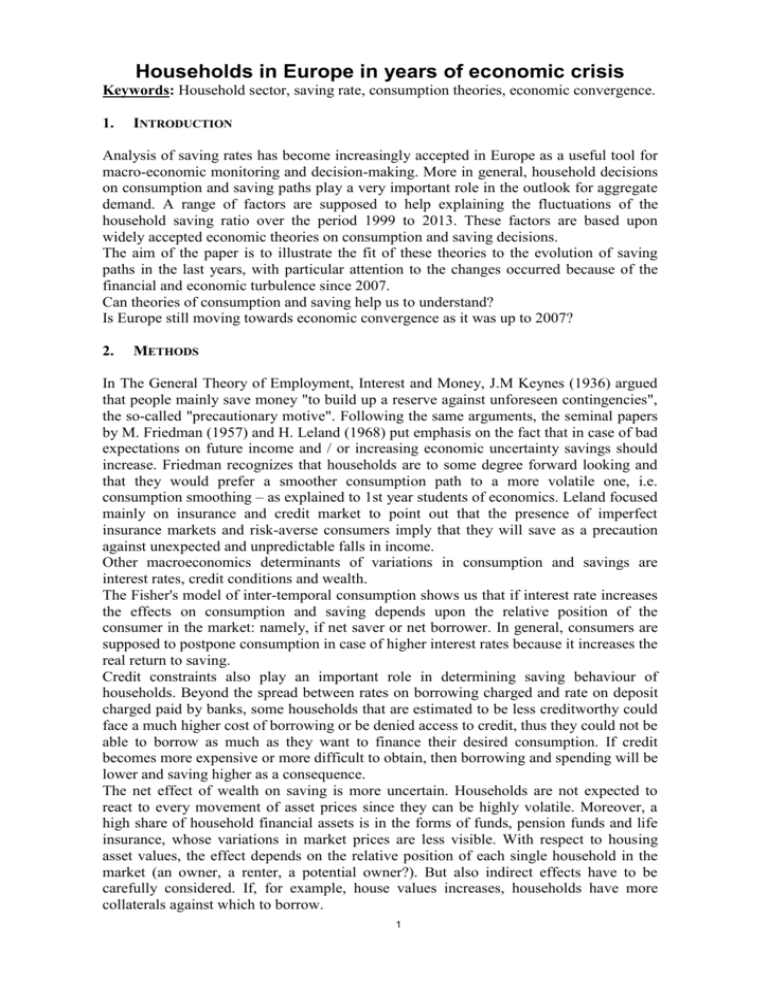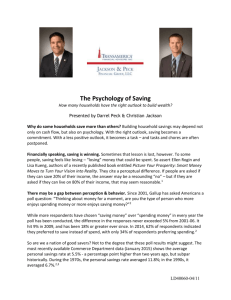1. Introduction
advertisement

Households in Europe in years of economic crisis Keywords: Household sector, saving rate, consumption theories, economic convergence. 1. INTRODUCTION Analysis of saving rates has become increasingly accepted in Europe as a useful tool for macro-economic monitoring and decision-making. More in general, household decisions on consumption and saving paths play a very important role in the outlook for aggregate demand. A range of factors are supposed to help explaining the fluctuations of the household saving ratio over the period 1999 to 2013. These factors are based upon widely accepted economic theories on consumption and saving decisions. The aim of the paper is to illustrate the fit of these theories to the evolution of saving paths in the last years, with particular attention to the changes occurred because of the financial and economic turbulence since 2007. Can theories of consumption and saving help us to understand? Is Europe still moving towards economic convergence as it was up to 2007? 2. METHODS In The General Theory of Employment, Interest and Money, J.M Keynes (1936) argued that people mainly save money "to build up a reserve against unforeseen contingencies", the so-called "precautionary motive". Following the same arguments, the seminal papers by M. Friedman (1957) and H. Leland (1968) put emphasis on the fact that in case of bad expectations on future income and / or increasing economic uncertainty savings should increase. Friedman recognizes that households are to some degree forward looking and that they would prefer a smoother consumption path to a more volatile one, i.e. consumption smoothing – as explained to 1st year students of economics. Leland focused mainly on insurance and credit market to point out that the presence of imperfect insurance markets and risk-averse consumers imply that they will save as a precaution against unexpected and unpredictable falls in income. Other macroeconomics determinants of variations in consumption and savings are interest rates, credit conditions and wealth. The Fisher's model of inter-temporal consumption shows us that if interest rate increases the effects on consumption and saving depends upon the relative position of the consumer in the market: namely, if net saver or net borrower. In general, consumers are supposed to postpone consumption in case of higher interest rates because it increases the real return to saving. Credit constraints also play an important role in determining saving behaviour of households. Beyond the spread between rates on borrowing charged and rate on deposit charged paid by banks, some households that are estimated to be less creditworthy could face a much higher cost of borrowing or be denied access to credit, thus they could not be able to borrow as much as they want to finance their desired consumption. If credit becomes more expensive or more difficult to obtain, then borrowing and spending will be lower and saving higher as a consequence. The net effect of wealth on saving is more uncertain. Households are not expected to react to every movement of asset prices since they can be highly volatile. Moreover, a high share of household financial assets is in the forms of funds, pension funds and life insurance, whose variations in market prices are less visible. With respect to housing asset values, the effect depends on the relative position of each single household in the market (an owner, a renter, a potential owner?). But also indirect effects have to be carefully considered. If, for example, house values increases, households have more collaterals against which to borrow. 1 The main problem of Friedman's theoretical model of permanent income is a pure empirical one: how is it possible to identify situations where income changes in a predictable way to properly "test" the validity of the model? Moreover, liquidity and credit constraints play a crucial role in the critique of Friedman's model, since their effects were not deeply analysed and discussed. In the presence of liquidity and credit constraint consumers cannot borrow in anticipation of an income increase, thus consumption will change at the time of income increase only! To overtake this point from a theoretical perspective the model recently developed by T. Jappelli and L. Pistaferri (2010) shows that consumption should react to unexpected income shocks conditionally on the characteristics of the shocks themselves and on the previously discussed constraints. Consumer should not respond therefore to anticipated income changes simply because in most cases this is not a viable option. Basic accounting identities for households sector: (1) B8G = B6G – P31, where B8G is savings, B6G gross disposable income and P31 final consumption expenditure. (2) Saving rate = B8G / (B6G + D8net), where D8net is the change in the net equity of households in pension funds reserves. 3. RESULTS The importance of households sector in Sector Accounts: In terms of gross disposable income, the households and non-profit institutions serving households sectors (S14 + S15) share of domestic sectors (S1) is similar almost everywhere and in all time span 1999-2013. Also in "non-western" countries like China and in Russia it is constantly around 60%. Comparing 2007-2012 to 1999-2007 in terms of nominal earning and spending growth in big EU countries and also Australia, China, Japan, Russia and the US, only Germany and Sweden are performing better after 2007 in terms of both the variables. Focusing on Europe, the difference between "core" and "periphery" Euro Area countries is evident. Pre-crisis, the economies (and the household sector) of Spain and Italy grew faster than the one of Germany, but they show no growth from 2007 onwards, whereas Germany kept on increasing since 2009, after a stable path in 2007-2009. B6G of households: (Italy + Spain) / Germany 110% 100% 90% 1999 2000 2001 2002 2003 2004 2005 2006 2007 2008 2009 2010 2011 2012 2013 If we now focus on saving rate of households, we observe flat paths in Germany and France, and a modest level shift in the UK. On the contrary, something changed for Spain and Italy after 2007. For Spain and Italy, classical theories can explain only Spain 2 between 2007 and 2009 – precautionary savings because of bad expectations on future income. S1M saving rate 20 Saving rate (DE, IT NET; ES, FR, UK GROSS) 18 16 14 12 Germany Italy 10 France Spain 8 United Kingdom 6 4 2 0 1999 2000 2001 2002 2003 2004 2005 2006 2007 2008 2009 2010 2011 2012 2013 If we also control for the effect of durable goods, we still observe constant paths for Germany and France. In UK lower spending on durables is "compensated" by higher savings after 2007. For Spain and Italy, we observe a constant decline of both savings and consumption on durable goods (except Spain between 2007 and 2009, only because of the saving boom). Germany increased financial assets and decreases financial liabilities from 2007 onwards. Italy did the opposite, whereas Spain liabilities increased a lot after 2007 and assets were almost stable. If we consider real assets and housing in particular, we observe that homeowners share is lower in Germany (44.2%) compared to the one of Italy (68.7%) and Spain (82.7%). Since housing play a decisive role in determining the net wealth of households, it is apparent that the relative position of Spain and Italy compared to Germany has changed a lot since 2007 because of the housing bubble that occurred in Spain and Italy, and not in Germany. Up to 2007, the correlation in the EU between earning (B6G) and spending (P31) was above 0.96 everywhere. During and after the financial and economic crisis, in some countries it has fallen below 0.9. In Italy it is 0.56 in 2007-2012, and in Spain it is -0.02 in the same period. Low correlation between B6G and P31 means no stable behaviour over time between consumption and saving. The same countries where correlation has fallen also show high variance in saving rate after 2007. It is apparent that both these two phenomena are related with uncertainty. 4. CONCLUSIONS The link between lack of correlation between B6G and P31 on the one hand and higher variance of saving rates on the other hand displays a picture where uncertainty on the future has increased to unpredictable levels in some EU countries from 2007 onwards. No "classical" theories seem to be able to explain this. A detailed comparison between "core" and "periphery" EU countries seems to suggest that Europe going from pre-crisis convergence to long term divergence, as argued by Wunsch (2013). The final version of the paper will include insights on the effects of the implementation of ESA2010 on saving rate of households. Preliminary results are available but are confidential till the deadline for NTTS Conference 2015 abstracts presentation. 3 REFERENCES [1] [2] [3] [4] [5] [6] [7] [8] ECB (2013), The Eurosystem Household Finance and Consumption Survey. Eurostat Sector Account database. M. Friedman (1957), The Permanent Income Hypothesis. Princeton University Press. T. Jappelli and L. Pistaferri (2010), The Consumption Response to Income Changes. NBER Working Paper No. 15739. J.M. Keynes (1936), The General Theory of Employment, Interest and Money. Palgrave Macmillan. H. Leland (1968), Saving and uncertainty: the precautionary demand for saving. The Quarterly Journal of Economics, Vol. 82, 465-473. OECD Sector Account database. P. Wunsch (2013), Is the European Integration Machine Broken?, InterEconomics, Vol. 48, No. 2. 4







